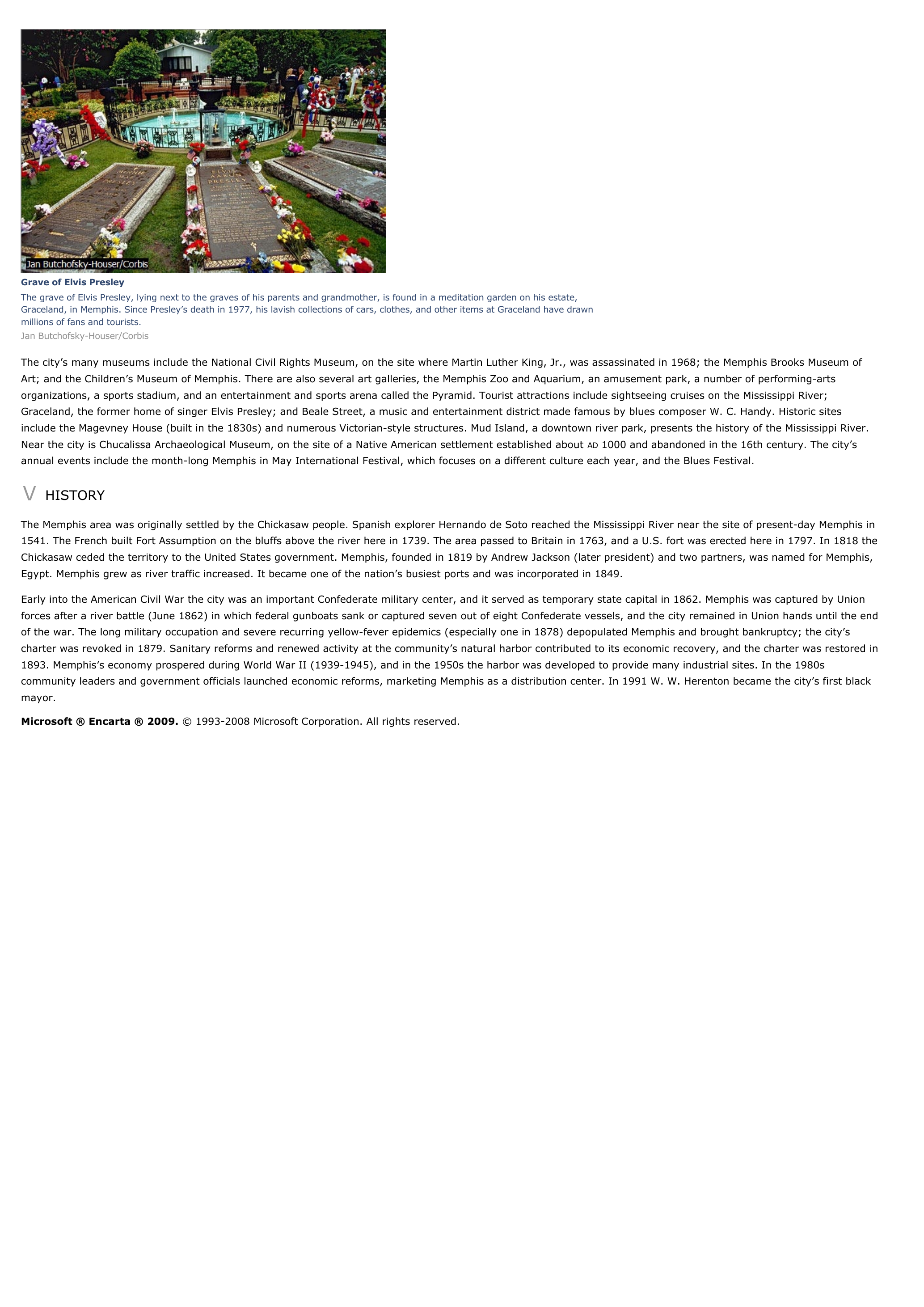Memphis (Tennessee) - geography.
Publié le 27/05/2013

Extrait du document


«
Grave of Elvis PresleyThe grave of Elvis Presley, lying next to the graves of his parents and grandmother, is found in a meditation garden on his estate,Graceland, in Memphis.
Since Presley’s death in 1977, his lavish collections of cars, clothes, and other items at Graceland have drawnmillions of fans and tourists.Jan Butchofsky-Houser/Corbis
The city’s many museums include the National Civil Rights Museum, on the site where Martin Luther King, Jr., was assassinated in 1968; the Memphis Brooks Museum ofArt; and the Children’s Museum of Memphis.
There are also several art galleries, the Memphis Zoo and Aquarium, an amusement park, a number of performing-artsorganizations, a sports stadium, and an entertainment and sports arena called the Pyramid.
Tourist attractions include sightseeing cruises on the Mississippi River;Graceland, the former home of singer Elvis Presley; and Beale Street, a music and entertainment district made famous by blues composer W.
C.
Handy.
Historic sitesinclude the Magevney House (built in the 1830s) and numerous Victorian-style structures.
Mud Island, a downtown river park, presents the history of the Mississippi River.Near the city is Chucalissa Archaeological Museum, on the site of a Native American settlement established about AD 1000 and abandoned in the 16th century.
The city’s annual events include the month-long Memphis in May International Festival, which focuses on a different culture each year, and the Blues Festival.
V HISTORY
The Memphis area was originally settled by the Chickasaw people.
Spanish explorer Hernando de Soto reached the Mississippi River near the site of present-day Memphis in1541.
The French built Fort Assumption on the bluffs above the river here in 1739.
The area passed to Britain in 1763, and a U.S.
fort was erected here in 1797.
In 1818 theChickasaw ceded the territory to the United States government.
Memphis, founded in 1819 by Andrew Jackson (later president) and two partners, was named for Memphis,Egypt.
Memphis grew as river traffic increased.
It became one of the nation’s busiest ports and was incorporated in 1849.
Early into the American Civil War the city was an important Confederate military center, and it served as temporary state capital in 1862.
Memphis was captured by Unionforces after a river battle (June 1862) in which federal gunboats sank or captured seven out of eight Confederate vessels, and the city remained in Union hands until the endof the war.
The long military occupation and severe recurring yellow-fever epidemics (especially one in 1878) depopulated Memphis and brought bankruptcy; the city’scharter was revoked in 1879.
Sanitary reforms and renewed activity at the community’s natural harbor contributed to its economic recovery, and the charter was restored in1893.
Memphis’s economy prospered during World War II (1939-1945), and in the 1950s the harbor was developed to provide many industrial sites.
In the 1980scommunity leaders and government officials launched economic reforms, marketing Memphis as a distribution center.
In 1991 W.
W.
Herenton became the city’s first blackmayor.
Microsoft ® Encarta ® 2009. © 1993-2008 Microsoft Corporation.
All rights reserved..
»
↓↓↓ APERÇU DU DOCUMENT ↓↓↓
Liens utiles
- Memphis (Tennessee) - geography.
- Hearns Thomas, né en 1958 à Memphis (Tennessee), boxeur américain.
- Franklin Aretha, née en 1942 à Memphis (Tennessee), chanteuse américaine.
- Tennessee (state) - geography.
- Williams Tennessee

































